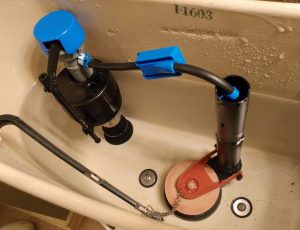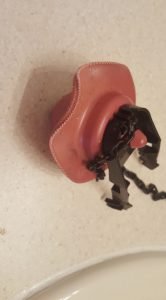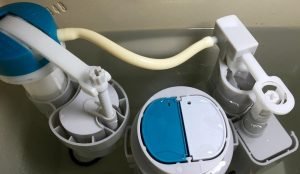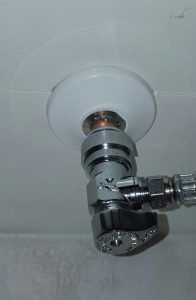Why Your Toilet Makes That Noise and How to Fix It
Last Updated on August 2, 2023 by toilethaven
The only sound you want to hear from your toilet is the whooshing sound it makes during flushing, not any other sound. But we don’t live in a perfect world.
If your toilet is making noise after flushing, the fill valve is either blocked or its seal is loose, restricting water flow and hence a high-pitched whistling noise. A toilet that makes noise when not in use is caused by a leaking flapper resulting in “ghost flushing.”
All toilets don’t make the same noise, though. Depending on your toilet’s underlying problem, you are likely to experience the following:
- The toilet makes a noise after flush.
- The toilet makes the noise randomly.
- The toilet makes a noise after filling.
- The toilet makes a high-pitched noise.
- Loud vibrating noise when flushing the toilet.
- The toilet makes a gurgling noise.
- The toilet makes a hissing sound.
If your toilet is making noise when not in use, it is a sign that the toilet flapper is allowing water to leak into the bowl. When the water level in the tank drops below the set level, the fill valve opens and starts filling the tank, a phenomenon known as ghost flushing.
Replace the fill valve to stop your toilet from making a high-pitched noise. Although it is possible to repair a fill valve, a replacement is the best and long-term solution. Toilet fill valves are also inexpensive and easy to replace.
Noises in toilets are a result of a faulty fill valve, flapper, flush valve, water supply line, or shut-off valve. A gurgling toilet noise indicates that your toilet drain/vent is clogged and backing up in your toilet bowl.
Sometimes replacing all the toilet tank parts makes more sense than just one part. Check out some of the best toilet tank repair kits in this post.
The gurgling toilet sound is often accompanied by bubbling at the bottom of the toilet bowl. The bubbles are a result of sewer gases escaping from the clogged drain. This can often result in a sewage smell in your bathroom.
Diagnosing Toilet Noises
If you notice that your toilet, apart from making a noise, is also constantly running, it is best to turn off the water to the toilet and only turn it on when you want to use the toilet. This temporary fix will give you peace, especially at night when sleeping, and conserve water.
When you are ready to fix the toilet, turn on the water to the toilet. Watch and listen carefully to where the noise is precisely coming from and what type of noise it is. Here is what you wind to find out:
1. A Hissing/Whistling/High-Pitched Noise
A hissing noise is a sign of a faulty fill valve/ballcock. A loose washer in the case of a ballcock or debris trapped inside the valve will restrict the flow of water to the tank resulting in a hissing/whistling sound due to the pressure of the water.
Here is how to remove debris from a hissing toilet fill valve:

- Turn off the water to the toilet. The shut-off valve will be located on the wall behind the toilet.
- Flush the toilet.
- Remove the toilet tank lid and place it away in a safe place.
- Your fill valve is the long toilet part on the left-hand side of your tank.
- On top of the fill valve, there is a cap. We want to remove this cap and check the condition of the seal.
- Hold the bottom of the fill valve shank with one hand, lift the toilet float all the way up, and hold it together with the cap with your other hand.
- Turn the fill valve cap 1/8 of a turn counterclockwise to remove it.
- You should now see the fill valve seal. Check for any debris clogging it.
- Hold a cup upside down over the fill valve and fully open the shut-off valve. The water pressure will push out the debris while, at the same time, the cap will prevent water from splashing all over your bathroom.
- Once fully unclogged, turn off the water.
- Put the fill valve cap back on.
If, even after removing the debris, your toilet is still making the hissing sound, you should go ahead and replace the fill valve. A fill valve costs about 20 dollars and is so easy to replace on your own. Here is how to replace a toilet fill valve.
If you have the old ballcock, you might consider replacing it with a modern toilet fill valve. Check out some of the best toilet fill valves in this post.
2. Ghost Flushing
Ghost flushing has nothing to do with ghosts but everything to do with a leaking or running toilet. When you have a slow-running or leaking toilet, the water level in the toilet tank will gradually reduce until the critical point when the toilet float will trigger the fill valve to start filling the tank. This could be why your toilet is making random noises.
What Causes Ghost Flushing?
- Faulty toilet flapper
- The tight flapper lift chain
- The toilet tank is leaking at the bottom.
- Cracked flush valve
- The refill tube is too deep in the overflow tube.
How can you fix the ghost-flushing toilet?
Faulty Toilet Flapper.

A toilet flapper is a rubber seal that sits at the bottom of the toilet tank on top of the flush valve opening. It is connected to the flushing handle by a lift chain. During flushing, it lifts off to allow water to move out of the tank and into the bowl.
When the flapper is not sealing properly, you will have a constantly running toilet. This means that water is continually being lost from your toilet tank. The toilet tank is always designed to contain a certain amount of water.
When the water in the tank falls beyond that level, the refill mechanism is triggered, and the fill valve refills the tank to compensate for the lost water. This goes on and on. This is the reason your toilet could be making noise after a few minutes.
Put some food color in the toilet tank and wait about 30 minutes. If you notice the food color in your toilet bowl, you have a leaking flapper or flush valve.
A leaking toilet flapper does not necessarily mean that it should be replaced. Sometimes there are mineral deposits and debris underneath the flapper and on top of the flush valve, preventing the flapper from making a good seal.
Here is how to fix it:
- Turn off the water to the toilet tank.
- Unhook the flapper from the overflow tube and lift chain.
- Inspect the bottom of the flapper and also the top of the flush valve for embedded dirt.
- If the flapper looks in good condition but there is dirt, clean it in a sink and clean the flush valve opening.
- Install it back and check if the leaking stops.
- If the flapper is worn out or warped, you will need to replace it. This is a detailed guide on how to replace a toilet flapper.
The above fix will mostly work on a ghost-flushing single-flush toilet. What if you have a dual flush toilet, which uses flush buttons?

A dual-flush toilet has a big valve assembly in the middle of the tank. Turn the valve counterclockwise to remove it. Inspect the seal at the bottom. Like a flapper, you will need to clean or replace it.
Flapper Lift Chain is Too Tight
If the toilet flapper is too tight, it will slightly unseat the toilet flapper from the flush valve. As a result, water will escape to the toilet bowl and ultimately trigger a ghost flush.
The lift chain should ideally have a ½ inch slack. Try to adjust the lift chain to make sure it is neither too tight nor too loose.
Cracked Flush Valve
A flush valve is the opening at the bottom of the toilet tank. Water flows from the tank to the bowl via the flush valve. The toilet flapper sits on top of the flush valve.
When the flush valve is cracked or worn out, water will slowly start to leak from the tank to the bowl. As a result, the toilet will constantly flush on its own as the fill valve compensates for the lost water.
A faulty flush valve will need to be replaced. To replace a flush valve, you will need first to remove the toilet tank. It is always a good time to replace the toilet tank bowl gasket and toilet tank bolts as you replace the flush valve.
Here is a detailed guide on how to replace a toilet flush valve.
The toilet tank is leaking from the base.
When a toilet is leaking from the base, it will either be where it is connected to the water supply line or the toilet tank bolts.
If the toilet tank bolts are leaking, you will need to tighten them and hope they work. If they don’t, you will have to remove the toilet tank, replace the bolts, steel washers, rubber washers, and the toilet tank to bowl gasket.
If the water supply line connection leaks, gently tighten it with a wrench and see if it stops. If it doesn’t, you should go ahead and replace it.
Refill the tube deep in the Overflow Tube.
A refill tube is a small tube connected from the fill valve to the overflow tube. During refilling, it sends a small amount of water down to the toilet bowl. This is the water you see at the bottom of the bowl, preventing sewer gases from entering the bathroom.
When the overflow tube is too long and deep in the overflow tube, it creates a siphon action and therefore prompts the fill valve to start refilling again.
Cut it into a small size and clip it on the top of the overflow tube.
3. Vibrating Toilet Noise
If, when flushing your toilet, you hear a loud vibrating noise, it points to a faulty toilet shut-off valve. The shut-off valve is the small knob on the wall behind your toilet. It uses a rubber washer for water isolation, which starts to vibrate when it becomes loose, causing noise in the water pipes.

To replace a toilet shut-off valve, start by shutting off the water at the main house shut-off valve. Open any of the faucets in the house to drain the pipes completely. Use 2 wrenches to loosen the old valve and install the new one. This should stop your toilet from making a vibrating noise.
4. Toilet Making a Gurgling Noise
Unlike other toilet noises, a gurgling sound comes from the toilet bowl. Most often, the toilet will also be bubbling. It is a sign of a clogged toilet drain, main drain, or clogged vent stuck.
Your toilet drain is connected to the main house drain and, ultimately, to the city sewer lines. It also has a vent that removes air through the top of the roof.
If the drains or the vent stuck are clogged, the air in the drains will have nowhere to flow out to and force its way through the water at the bottom of the toilet bowl, making a gurgling sound.
Unclogging your toilet drain or vent can fix this problem. Here is a detailed guide on how to fix a gurgling toilet.
Conclusion
A noisy toilet is irritating and expensive because, most of the time, it involves wasting water. Fixing it can be very simple, and you don’t need to call in a plumber. The replacement parts are also cheap.